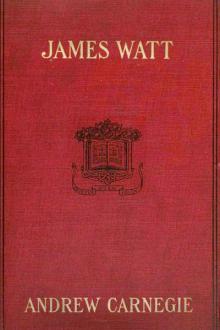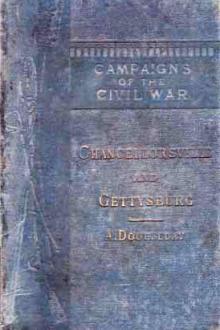James Watt, Andrew Carnegie [fiction book recommendations txt] 📗

- Author: Andrew Carnegie
- Performer: -
Book online «James Watt, Andrew Carnegie [fiction book recommendations txt] 📗». Author Andrew Carnegie
With the beginning of the new century, 1800, the original partnership of the famous firm of Boulton and Watt expired, after a term of twenty-five years, as did the patents of 1769 and 1775. The term of partnership had been fixed with reference to the duration of the patents. Young men in their prime, Watt at forty and Boulton about fifty when they joined hands, after a quarter-century of unceasing and anxious labor, were disposed to resign the cares and troubles of business to their sons. The partnership therefore was not renewed by them, but their respective shares in the firm were agreed upon as the basis of a new partnership between their sons, James Watt, Jr., Matthew Robinson Boulton and Gregory Watt, all distinguished for abilities of no mean order, and in a great degree already conversant with the business, which their wise fathers had seen fit for some years to entrust more and more to them.
In nothing done by either of these two wise fathers is more wisdom shown than in their sagacious, farseeing policy in regard to their sons. As they themselves had been taught to concentrate their energies upon useful occupation, for which society would pay as for value received, they had doubtless often conferred, and concluded that was the happiest and best life for their sons, instead of allowing them to fritter away the precious years of youth in aimless frivolity, to be followed in later years by a disappointing and humiliating old age.
So the partnership of Boulton and Watt was renewed in the union of the sons. Gregory Watt's premature death four years later was such a blow to his father that some think he never was quite himself again. Gregory had displayed brilliant talents in the higher pursuits of science and literature, in which he took delight, and great things had been predicted from him. With the other two sons the business connection continued without change for forty years, until, when old men, they also retired like their fathers. They proved to be great managers, for notwithstanding the cessation of the patents which opened engine-building free to all, the business of the firm increased and became much more profitable than it had ever been before; indeed toward the close of the original partnership, and upon the triumph gained in the patent suits, the enterprise became so profitable as fully to satisfy the moderate desire of Watt, and to provide a sure source of income for his sons. This met all his wishes and removed the fears of becoming dependent that had so long haunted him.
The continued and increasing success of the Soho works was obviously owing to the new partners. They had some excellent assistants, but in the foremost place among all of them stands Murdoch, Watt's able, faithful and esteemed assistant for many years, who, both intellectually and in manly independence, was considered to exhibit no small resemblance to his revered master and friend. Never formally a partner in Soho (for he declined partnership as we have seen), he was placed on the footing of a partner by the sons in 1810, without risk, and received $5,000 per annum. From 1830 he lived in peaceful retirement and passed away in 1839. His remains were deposited in Handsworth Church near those of his friends and employers, Watt and Boulton (the one spot on earth he could have most desired). "A bust by Chantrey serves to perpetuate the remembrance of his manly and intelligent features, and of the mind of which these were a pleasing index." We may imagine the shades of Watt and Boulton, those friends so appropriately laid together, greeting their friend and employee: "Well done, thou good and faithful servant!" If ever there was one, Murdoch was the man, and Captain Jones his fellow.
We have referred to Watt's suggestion of the screw-propeller, and of the sketch of it sent to Dr. Small, September 30, 1770. The only record of any earlier suggestion of steam is that of Jonathan Hulls, in 1736, and which he set forth in a pamphlet entitled "A Description and Draught of a Newly Invented Machine for carrying vessels or ships out of or into any Harbour, Port or River, against Wind or Tide or in a Calm"; London, 1737. He described a large barge equipped with a Newcomen engine to be employed as a tug, fitted with fan (or paddle) wheels, towing a ship of war, but nothing further appears to have been done. Writing on this subject, Mr. Williamson says:
During his last visit to Greenock in 1816, Mr. Watt, in company with his friend, Mr. Walkinshaw—whom the author some years afterward heard relate the circumstance—made a voyage in a steamboat as far as Rothsay and back to Greenock—an excursion, which, in those days, occupied a greater portion of a whole day. Mr. Watt entered into conversation with the engineer of the boat, pointing out to him the method of "backing" the engine. With a footrule he demonstrated to him what was meant. Not succeeding, however, he at last, under the impulse of the ruling passion, threw off his overcoat, and, putting his hand to the engine himself, showed the practical application of his lecture. Previously to this, the "back-stroke" of the steamboat engine was either unknown, or not generally known. The practice was to stop the engine entirely a considerable time before the vessel reached the point of mooring, in order to allow for the gradual and natural diminution of her speed.
The naval review at Spithead, upon the close of the Crimean war in 1856, was the greatest up to that time. Ten vessels out of two hundred and fifty still had not steam power, but almost all the others were propelled by the screw—the spiral oar of Watt's letter of 1770—a red-letter day for the inventor.
Watt's early interest in locomotive steam-carriages, dating from Robison's having thrown out the idea to him, was never lost. On August 12, 1768, Dr. Small writes Watt, referring to the "peculiar improvements in them" the latter had made previous to that date. Seven months later he apprises Watt that "a patent for moving wheel-carriages by steam has been taken out by one Moore," adding "this comes of thy delays; do come to England with all possible speed." Watt replied "If linen-draper Moore does not use my engine to drive his chaises he can't drive them by steam." Here Watt hit the nail on the head; as with the steamship, so with the locomotive, his steam-engine was the indispensable power. In 1786 he states that he has a carriage model of some size in hand "and am resolved to try if God will work a miracle in favor of these carriages." Watt's doubt was based on the fact that they would take twenty pounds of coal and two cubic feet of water per horse-power on the common roads.
Another of Watt's recreations in his days of semi-retirement was the improvement of lamps. He wrote the famous inventor of the Argand burner fully upon the subject in August, 1787, and constructed some lamps which proved great successes.
The following year he invented an instrument for determining the specific gravities of liquids, which was generally adopted.
One of Watt's inventions was a new method of readily measuring distances by telescope, which he used in making his various surveys for canals. Such instruments are in general use to-day. Brough's treatise on "Mining" (10th ed., p. 228) gives a very complete account of them, and states that "the original instrument of this class is that invented by James Watt in 1771."
In his leisure hours, Watt invented an ingenious machine for drawing in perspective, using the double parallel ruler, then very little known and not at all used as far as Watt knew. Watt reports having made from fifty to eighty of these machines, which went to various parts of the world.
In 1810 Watt informs Berthollet that for several years he had felt unable, owing to the state of his health, to make chemical experiments. But idle he could not be; he must be at work upon something. As he often said, "without a hobby-horse, what is life?" So the saying is reported, but we may conclude that the "horse" is here an interpolation, for the difference between "a horse" and "a hobby" is radical—a man can get off a horse.
Watt's next "hobby" fortunately became an engrossing occupation and kept him alert. This was a machine for copying sculpture. A machine he had seen in Paris for tracing and multiplying the dies of medals, suggested the other. After much labor and many experiments he did get some measure of success, and made a large head of Locke in yellow wood, and a small head of his friend Adam Smith.
Long did Watt toil at the new hobby in the garret where it had been created, but the garret proved too hot in summer and too cold in winter. March 14, 1810, he writes Berthollet and Levèque:
I still do a little in mechanics: a part of which, if I live to complete it, I shall have the honor of communicating to my friends in France.
He went steadily forward and succeeded in making some fine copies in 1814. For one of Sappho he gives dates and the hours required for various parts, making a total of thirty-nine. Some censorious Sabbatarians discovered that the day he was employed one hour "doing her breast with 1/8th drill" was Sabbath, which in one who belonged to a strict Scottish Covenanter family, betokened a sad fall from grace. When we consider that his health was then precarious, that he was debarred from chemical experiments, and depended solely upon mechanical subjects; that in all probability it was a stormy day (Sunday, February 3, 1811), knowing also that "Satan finds mischief still for idle hands to do," we hope our readers will pardon him for yielding to the irresistible temptation, even if on the holy Sabbath day for once he could not "get off" his captivating hobby.
The historical last workshop of the great worker with all its contents remains open to the public to-day just as it was when he passed away. Pilgrims from many lands visit it, as Shakespeare's birthplace, Burns' cottage, and Scott's Abbottsford attract their many thousands yearly. We recommend our readers to add to these this garret of Watt in their pilgrimages.
[1] Sinclair's "Development of the Locomotive" tends to deprive Stephenson of some part of his fame as inventor. Much importance is attached to Hedley's "Puffing Billy," 1813, which is pronounced to have been a commercial success. Sinclair, however, credits Stephenson with doing most of all men to introduce the Locomotive. As the final verdict may admit Hedley and cannot expel Stephenson from the temple of fame, we pass the sentence as written, leaving to future disputants to adjust rival claims.
CHAPTER VIII
The Record of the Steam Engine
The Soho works, up to January, 1824, had completed 1164 steam engines, of a nominal horse-power of 25,945; from January, 1824, to 1854, 441 engines, nominal horse-power, 25,278, making the total number 1605, of nominal horse-power, 51,223, and real horse-power, 167,319. Mulhall gives the total steam-power of the world as 50,150,000 horse-power in 1888. In 1880 it was only 34,150,000. Thus in eight years it increased, say, fifty per cent. Assuming the same rate of increase from 1888 to 1905, a similar period, it is to-day 75,000,000





Comments (0)